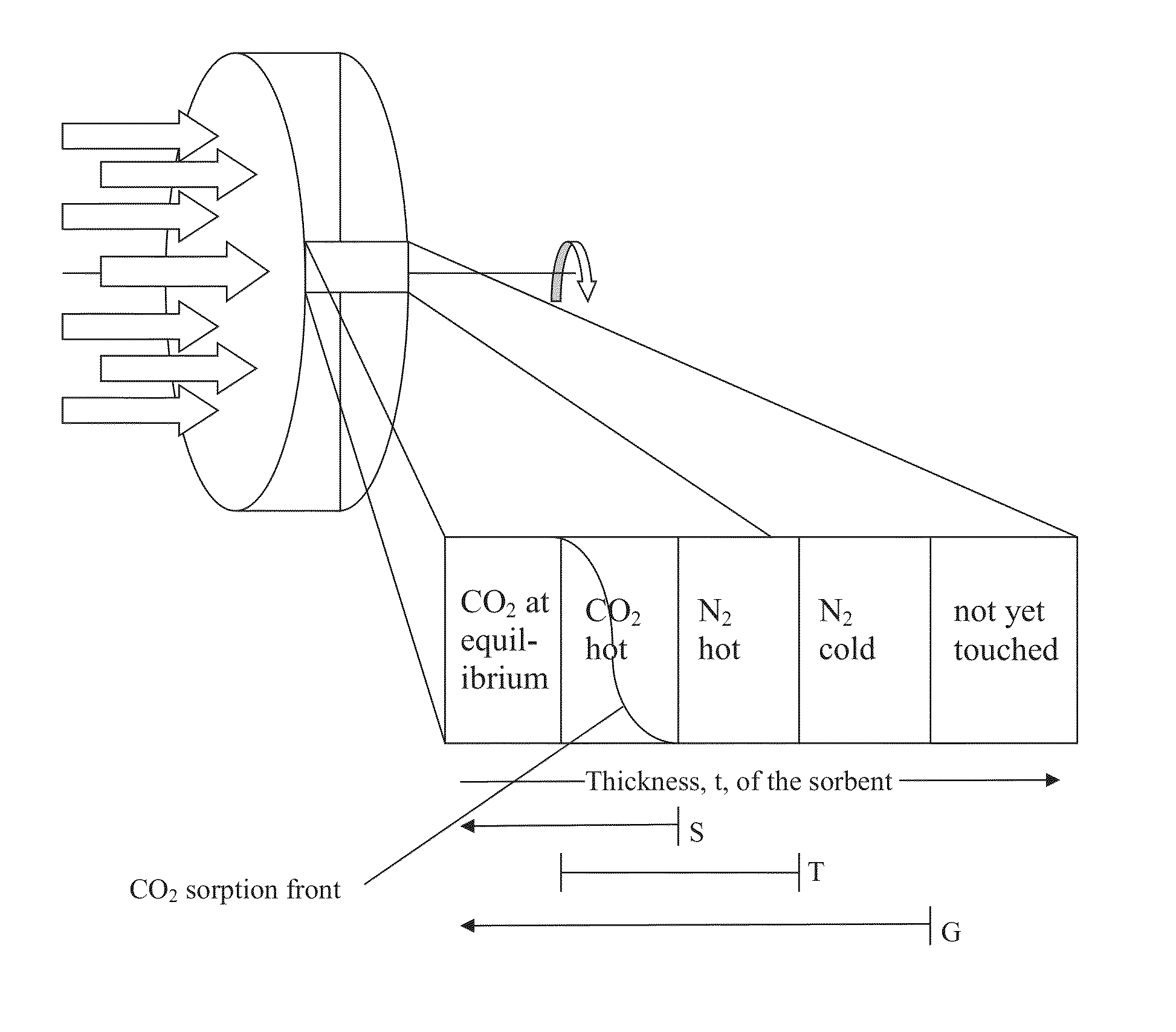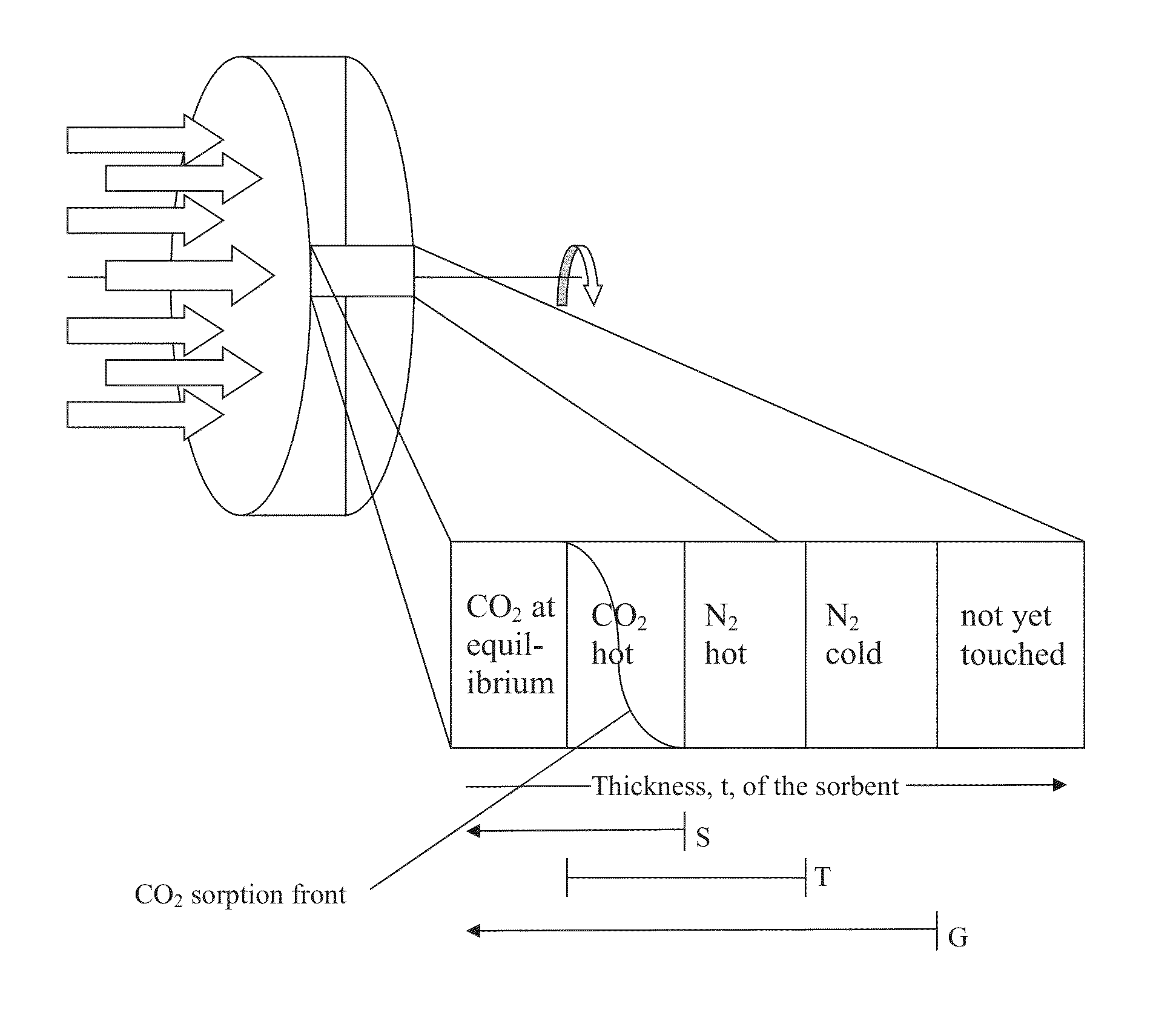CO2 capture processes using rotary wheel configurations
a technology of rotary wheels and capture processes, applied in the direction of separation processes, dispersed particle separation, chemistry apparatuses and processes, etc., can solve the problems of capital and energy consumption of traditional approaches, and achieve the effects of reducing sorption capacity, increasing heat management, and serving to remove hea
- Summary
- Abstract
- Description
- Claims
- Application Information
AI Technical Summary
Benefits of technology
Problems solved by technology
Method used
Image
Examples
embodiment 1
[0055]A method for enhanced control, separation, and / or purification of CO2 gas from one or more sources having a mixture of gases, the method comprising: providing a solid monolithic sorbent material having a thickness and a selectivity for CO2 sorption in a continuous or semi-continuous sorption-desorption process comprising a CO2 sorption step and a CO2 desorption step, but not comprising either a drying step or a separate cooling step: providing one or more mixed gas sources containing CO2 gas at a feed temperature, such that the mixed gas source(s) collectively exhibit not more than 70% water vapor saturation; adding liquid phase water droplets to the mixed gas source(s) to form a dual phase sorption feedstream containing CO2 and H2O at approximately the feed temperature, the amount of liquid phase water being sufficient to cause the dual phase sorption feedstream to have at least 99% water vapor saturation at a desorption temperature, which is higher than the feed temperature,...
embodiment 2
[0056]The method of embodiment 1, wherein an amount of liquid phase water droplets is added per gram of all combined mixed gas sources, so as to satisfy the following inequality: Cp,solid / Cp,gasp,solid represents the average heat capacity of the solid monolithic sorbent, Cp,gas represents the average heat capacity of the dual phase sorption feed, F is a factor of approximately ⅔, Y represents a mole fraction of CO2 gas in gas phase, and q represents an amount of CO2 adsorbed in equilibrium with a gas phase having composition Y, such that a Cp,gas of the dual phase sorption liquid is at least about 300% (e.g., at least about 500%) greater than a collective Cp,gas of all combined mixed gas sources.
embodiment 3
[0057]A method for enhanced control, separation, and / or purification of CO2 gas from one or more sources having a mixture of gases, the method comprising: providing a solid monolithic sorbent material having a thickness and a selectivity for CO2 sorption in a continuous or semi-continuous sorption-desorption process comprising a CO2 sorption step and a CO2 desorption step, but not comprising either a drying step or a separate cooling step: providing one or more mixed gas sources containing CO2 gas at a feed temperature, such that the mixed gas source(s) collectively exhibit not more than 70% water vapor saturation; adding liquid phase water droplets to the mixed gas source(s) to form a dual phase sorption feedstream containing CO2 and H2O at approximately the feed temperature, the amount of liquid phase water being sufficient to cause the dual phase sorption feedstream to have at least 99% water vapor saturation at a desorption temperature, which is higher than the feed temperature,...
PUM
| Property | Measurement | Unit |
|---|---|---|
| temperature | aaaaa | aaaaa |
| feed temperature | aaaaa | aaaaa |
| inlet temperature | aaaaa | aaaaa |
Abstract
Description
Claims
Application Information
 Login to View More
Login to View More - R&D
- Intellectual Property
- Life Sciences
- Materials
- Tech Scout
- Unparalleled Data Quality
- Higher Quality Content
- 60% Fewer Hallucinations
Browse by: Latest US Patents, China's latest patents, Technical Efficacy Thesaurus, Application Domain, Technology Topic, Popular Technical Reports.
© 2025 PatSnap. All rights reserved.Legal|Privacy policy|Modern Slavery Act Transparency Statement|Sitemap|About US| Contact US: help@patsnap.com


